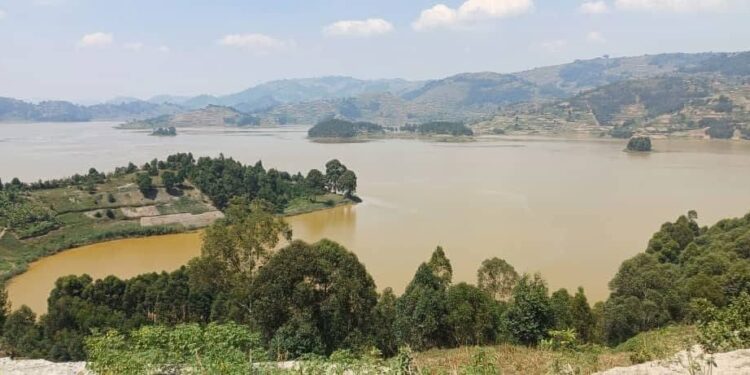KABALE, UGANDA: 02 September 2025 – The Ministry of Water and Environment has issued an official statement addressing the severe environmental crisis at Lake Bunyonyi, where the water has turned a brownish color, and is emitting a foul odor. The ministry’s statement, released on September 2, 2025, confirmed that a combination of natural processes, human activity, and low oxygen levels are threatening the lake’s ecosystem.
The discoloration of Lake Bunyonyi’s water, which locals say typically only lasts a few days after heavy rains, has persisted for over three weeks. This has caused alarm among residents, many of whom rely on the lake for domestic water needs. The National Water and Sewerage Corporation (NWSC) has faced challenges with water treatment due to the high turbidity and color, leading some residents to seek alternative water sources, as they perceive the treated water to be unsafe for consumption.
Lake Bunyonyi is located in southwestern Uganda, situated between the Districts of Kisoro and Rubanda in the Ruhezamyenda Catchment. It has an average depth of 39m and a reported maximum depth of 900m. With 29 islands and terraced hills surrounding it, the lake is a unique ecological and tourism destination. However, the growing
environmental pressures threaten the lake’s fragile ecosystem.
According to the statement, the Ministry of Water and Environment conducted a rapid assessment that included field observations and water quality analysis. The findings identified the following key factors contributing to the lake’s deterioration:
* Lake Turnover: Heavy rainfall can cause the lake’s deeper, colder water to mix with the warmer surface water, increasing turbidity.
* Human Activity and Runoff: The lake’s steep valley location makes it susceptible to runoff from agricultural farms and settlements. Stone quarrying and iron ore mining in the catchment area are also contributing to siltation, which gives the water its brown color.
* Poor Waste Management: The absence of adequate sanitation facilities at the Harutindo Landing Centre market and potential wastewater discharge from some of the 46 hotels on the lakeshores are contributing to the decline in water quality. These issues are believed to be the cause of the foul odor, oily film, and white cream on the water’s surface.
* Low Oxygen Levels: Water quality analysis revealed an alarmingly low mean Dissolved Oxygen (DO) level of 1.60 mg/L. These hypoxic conditions mean that most fish species cannot survive, and have led to aquatic life moving to the surface in search of oxygen. The ministry also debunked earlier media reports of volcanic activity, stating there was no evidence of tremors or water turbulence to support this claim.
In response to the crisis, the Ministry of Water and Environment, in partnership with other agencies, has outlined a series of actions. Short-term plans (within one year) include conducting a comprehensive assessment of businesses around the lake to enforce environmental regulations and launching public awareness campaigns. The NWSC is also upgrading its treatment technology to ensure the water meets safety standards.
For the medium to long term (1 to 5 years), the ministry plans to scale up catchment protection to prevent soil erosion, promote sustainable farming practices, and provide alternative income sources for upstream communities to incentivize conservation efforts. The government will also collaborate with local authorities to establish proper sanitation and waste management facilities to prevent the direct discharge of waste into the lake.






































